Understanding the Increasing Autism Prevalence
Autism Spectrum Disorder (ASD) has seen a striking increase in diagnoses over recent decades. This trend is the result of a complex interplay of genetic, environmental, diagnostic, and societal factors. In this article, we delve into the multifaceted reasons behind the rise in autism cases, how it is identified and treated, and what this growing awareness means for individuals, families, and healthcare systems.
What Is Autism Spectrum Disorder?
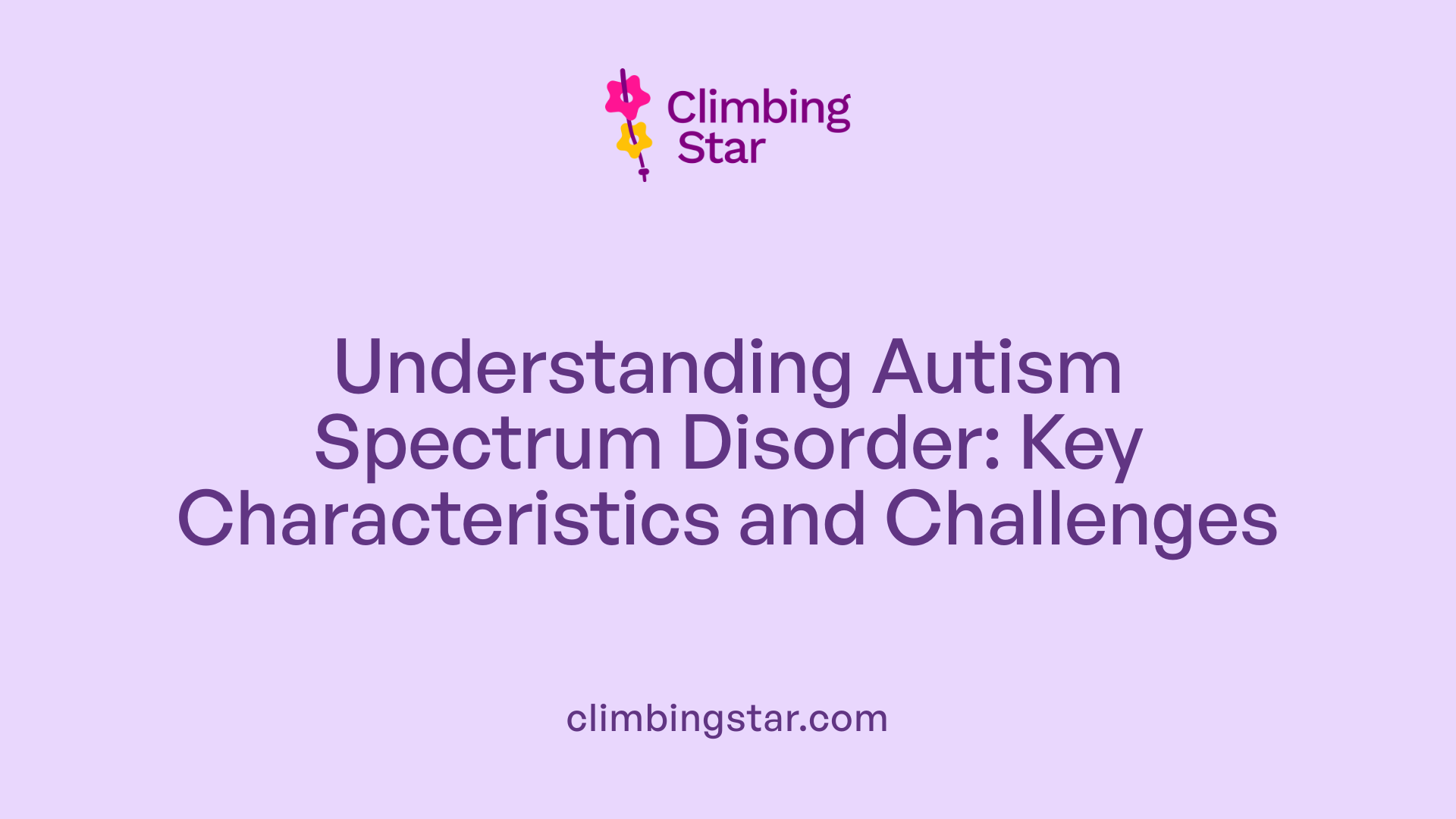
Definition and core characteristics of ASD
Autism Spectrum Disorder (ASD) is a neurodevelopmental condition that affects how people communicate, interact socially, and behave. It is marked by difficulties in social communication and language, along with repetitive behaviors and atypical patterns of activities. These characteristics vary significantly across individuals, creating a spectrum that includes a wide range of abilities and challenges.
Social communication difficulties
People with ASD often struggle with social interaction and communication. This includes challenges understanding and using verbal and nonverbal language, difficulties in forming and maintaining relationships, and problems with interpreting social cues. These social challenges can influence everyday interactions and limit social participation.
Repetitive behaviors and sensory sensitivity
ASD also involves restricted and repetitive behaviors such as repetitive movements, insistence on sameness, and intense focus on specific interests. In addition, many individuals with ASD experience sensory sensitivity, reacting unusually to sensory inputs like lights, sounds, textures, or smells. This sensory profile further shapes their experience of the environment and behavior.
Individuals with ASD present these core features to varying degrees, which makes the disorder highly heterogeneous. Understanding these aspects is essential for diagnosis and intervention approaches aimed at enhancing communication, social functioning, and quality of life.
Historical Context and Diagnostic Evolution of ASD

Early Research and Diagnostic History
Autism spectrum disorder (ASD) was first systematically described in the 1940s, marking the beginning of scientific interest and clinical awareness. Early work focused on identifying distinctive social and communication difficulties alongside repetitive behaviors. Over decades, research has steadily advanced, leading to refined diagnostic approaches that better capture the broad spectrum of autistic traits.
Changes in ASD Criteria Over Time
The criteria defining ASD have evolved significantly since its initial description. Early diagnostic frameworks identified narrow and specific features, often missing milder or atypical presentations. Advances in psychiatric classification systems expanded these criteria to include a wider range of behaviors and severity levels. The transition from distinct subtypes to a spectrum-oriented approach reflects greater understanding of autism’s heterogeneity.
How Broader Criteria Impact Diagnosis Rates
Broadening diagnostic criteria have been a major factor contributing to rising ASD prevalence rates. By encompassing individuals with less pronounced symptoms or co-occurring conditions, more people are identified as autistic. This shift explains much of the dramatic increase in diagnoses noted over recent decades, rather than a sudden rise in new cases. Consequently, the increasing rates signal better recognition and screening rather than an outright epidemic.
Genetic Underpinnings of Autism

Genetic mutations and copy number variations
Autism spectrum disorder (ASD) is strongly influenced by genetic factors, including various gene mutations and copy number variations (CNVs). These genetic alterations affect genes that regulate neuronal development and brain function. CNVs can involve deletions or duplications of large DNA segments, which disrupt normal gene dosage and contribute to ASD phenotypes.
Monogenic syndromes associated with ASD
Certain monogenic disorders have a well-established association with ASD. Syndromes such as fragile X syndrome, tuberous sclerosis, and Rett syndrome exemplify single-gene conditions that significantly increase autism risk. These syndromes provide crucial insights into molecular pathways implicated in ASD.
Heritability and twin studies
Twin studies underscore the strong heritability component of ASD, with concordance rates much higher in monozygotic twins compared to dizygotic ones. This highlights the important role of inherited genetic variations. Despite this, ASD results from complex interactions among multiple genes rather than a single genetic cause.
Risk genes and loci identified by SFARI
The Simons Foundation Autism Research Initiative (SFARI) has compiled an extensive list of risk genes and loci linked to ASD. This curated database includes high-confidence genes implicated through large-scale genomic studies. These genes often relate to synaptic function, neuronal communication, and chromatin remodeling.
| Genetic Aspect | Description | Significance in ASD Research |
|---|---|---|
| Gene mutations | Variants affecting neuronal development genes | Foundational causes of ASD in many cases |
| Copy number variations (CNVs) | DNA deletions/duplications impacting gene dosage | Common in ASD, affecting brain pathways |
| Monogenic syndromes | Fragile X, tuberous sclerosis, Rett syndrome | Model disorders for understanding autism risk |
| Twin studies | Elevated concordance in identical twins | Demonstrates strong genetic heritability |
| SFARI risk genes and loci | Compilation of ASD-associated genes from research | Guides functional and therapeutic target discovery |
This genetic knowledge forms the basis for ongoing efforts to unravel autism’s biological basis and advance precision medicine approaches.
Environmental Influences Contributing to ASD Risk
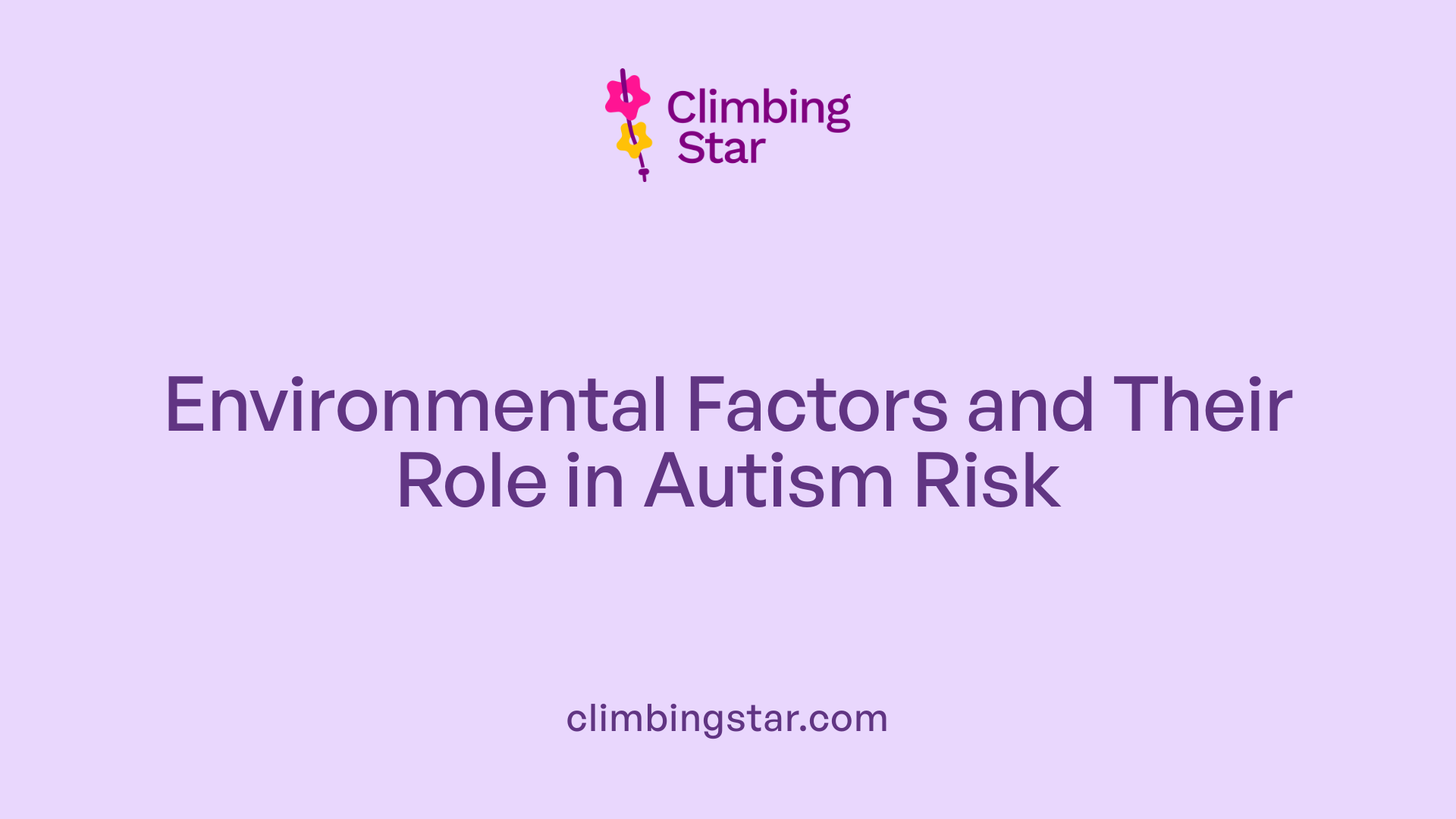
Advanced Parental Age
Advanced parental age has been identified as a significant environmental risk factor for autism spectrum disorders (ASD). Both older maternal and paternal ages increase the likelihood of ASD in offspring, possibly due to accumulated genetic mutations or epigenetic changes affecting neurodevelopment.
Maternal Diabetes and Infections
Maternal health conditions such as gestational diabetes and infections during pregnancy are closely linked to higher ASD risk. These conditions can cause oxidative stress, immune activation, and neuroinflammation in the developing fetus, disrupting normal brain development.
Exposure to Pollutants and Nutrient Deficiencies
Environmental pollutants—like heavy metals and air contaminants—along with nutrient deficiencies during prenatal development, are associated with increased ASD risk. These exposures can interfere with neuronal growth and function through mechanisms like oxidative stress and mitochondrial dysfunction.
Prenatal Hormone Imbalances
Abnormal steroid hormone levels during pregnancy have been implicated in ASD etiology. Hormonal imbalances may affect brain sexual differentiation and other neurodevelopmental processes, contributing to the disorder's emergence.
Gene-Environment Interactions
ASD develops from complex interactions between genetic susceptibilities and environmental triggers. Certain genes involved in neuronal development become detrimental only when combined with specific environmental exposures, highlighting the importance of studying both genetic and environmental factors in tandem.
| Environmental Influence | Description | Mechanism |
|---|---|---|
| Advanced Parental Age | Increased risk from older parents | Accumulation of genetic mutations |
| Maternal Diabetes & Infections | Higher ASD prevalence with maternal health issues | Oxidative stress, immune activation |
| Pollutants & Nutrient Deficiencies | Exposure to toxins and lack of nutrients | Neuroinflammation, mitochondrial dysfunction |
| Prenatal Hormone Imbalances | Hormone fluctuations affecting fetal brain development | Altered neurodevelopmental programming |
| Gene-Environment Interactions | Genetic vulnerability combined with environmental factors | Epigenetic modifications activating risk |
Biological Mechanisms Linking Environment and Autism
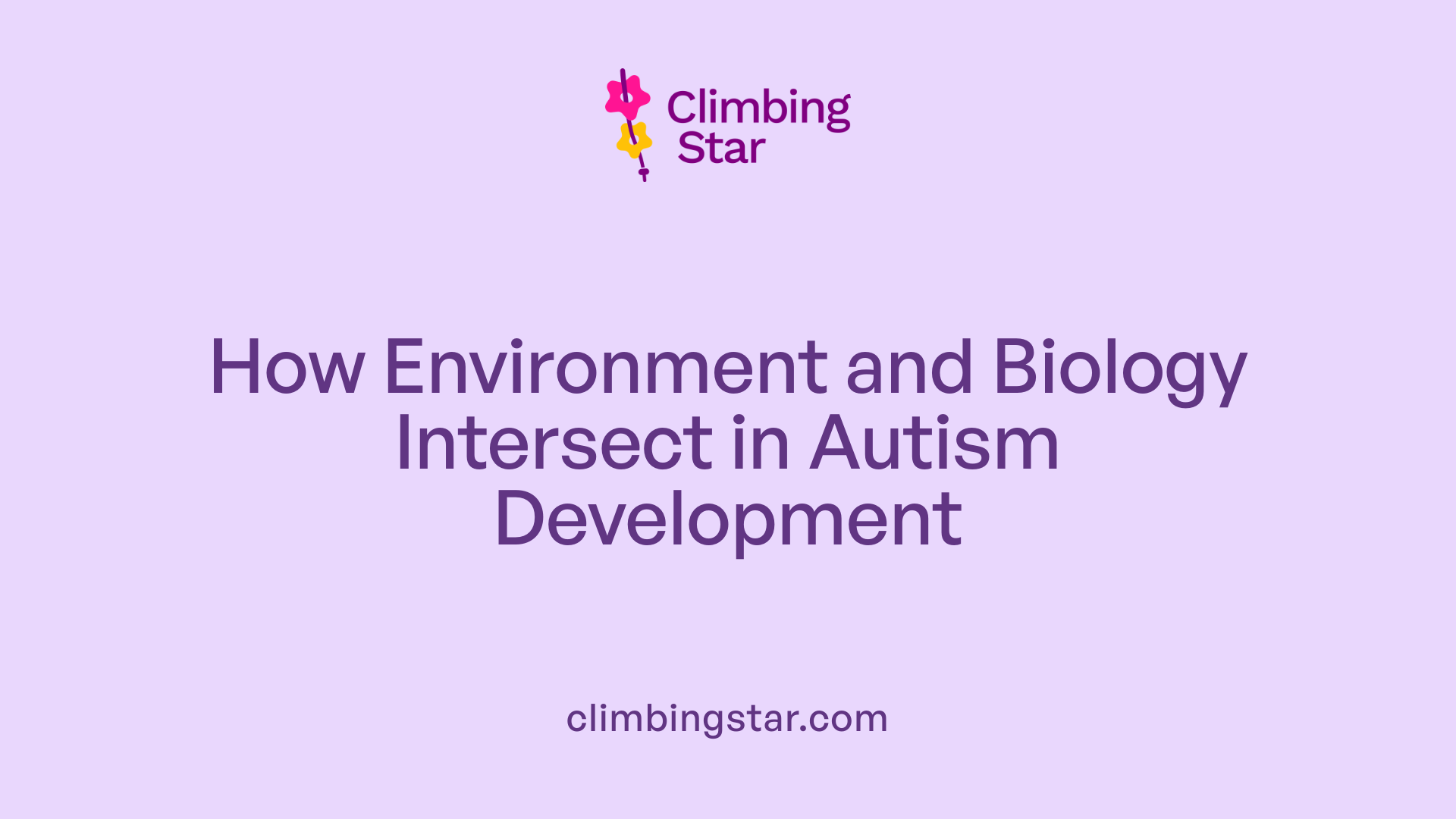
How Does Immune System Activation Relate to Autism?
Research indicates that environmental exposures during early life can trigger immune system activation, which plays a significant role in autism spectrum disorder (ASD) development. This immune activation may influence brain development by promoting neuroinflammatory processes, disrupting the typical maturing of neural circuits critical for social communication and behavior.
What Roles Do Oxidative Stress and Neuroinflammation Have?
Oxidative stress involves an imbalance between reactive oxygen species and antioxidants, causing cellular damage. In ASD, oxidative stress has been implicated as a contributing factor that exacerbates neuroinflammation in the developing brain. Together, these processes may lead to altered neuronal connectivity and function, influencing ASD symptoms.
How Does Mitochondrial Dysfunction Connect to ASD?
Mitochondrial dysfunction is another crucial biological mechanism linking environmental risks to autism. Impaired mitochondrial function can reduce cellular energy production, increase oxidative stress, and promote neuroinflammation. These effects can impair neurodevelopmental processes, especially in vulnerable individuals exposed to environmental insults.
What Is the Impact of Maternal Conditions Like Gestational Diabetes?
Maternal conditions such as gestational diabetes are strongly associated with increased ASD risk. The mechanisms involve heightened oxidative stress and mitochondrial dysfunction in the prenatal environment, potentially disrupting fetal brain development. This disruption might result from altered glucose metabolism and inflammatory responses that adversely affect the neurodevelopmental trajectory of the fetus.
These interconnected pathways—immune activation, oxidative stress, neuroinflammation, and mitochondrial dysfunction—highlight how environmental and maternal factors may contribute mechanistically to the onset or exacerbation of ASD during critical developmental windows.
Expanded Autism Diagnosis: Awareness, Screening, and Societal Factors
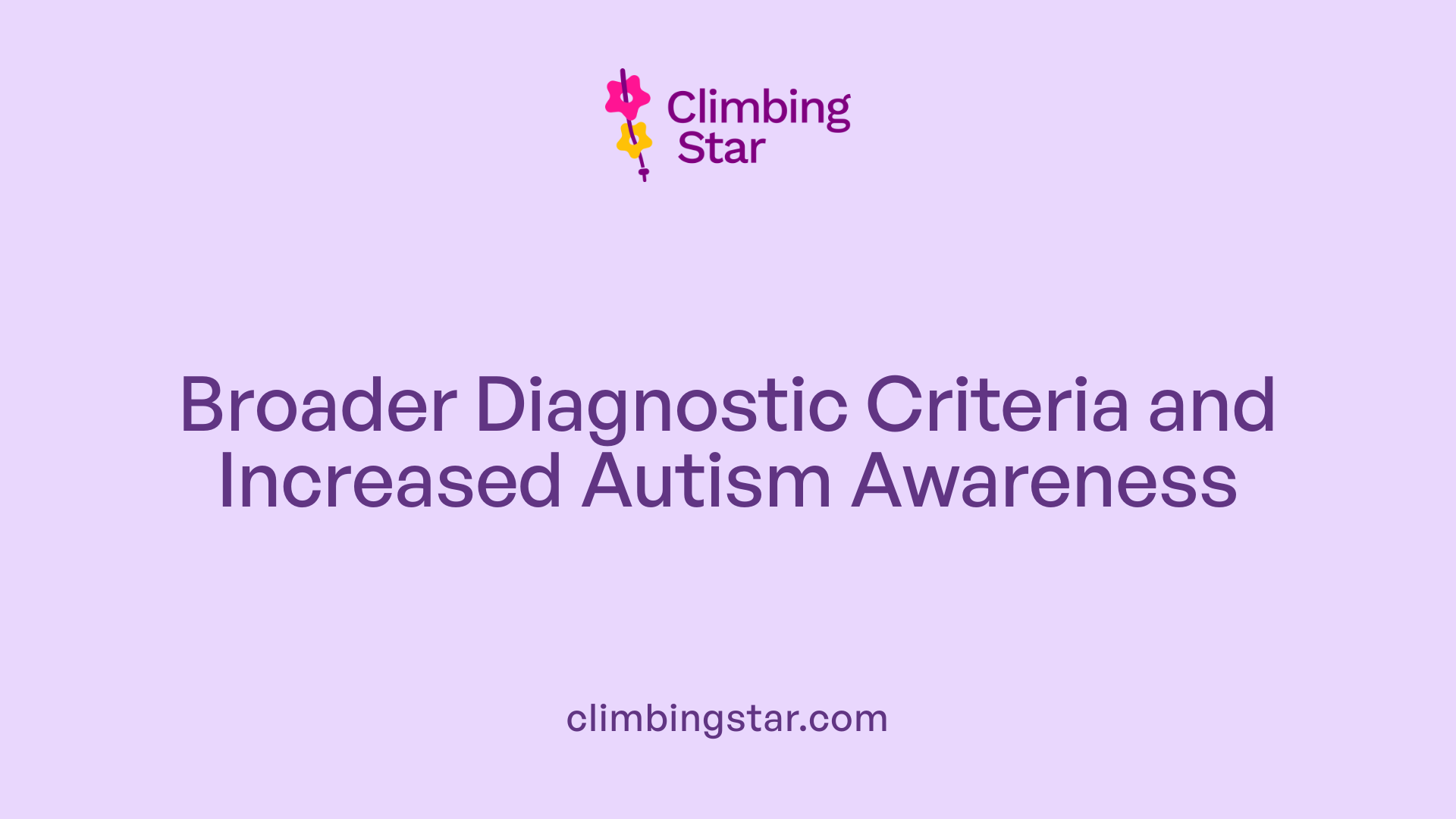
Broadened Diagnostic Criteria
Over the past two decades, autism diagnosis rates have significantly increased, largely due to expanded diagnostic criteria. These broader definitions now encompass a wider range of autistic traits and behaviors, allowing more subtle or atypical presentations to be identified. This change has played a major role in the rising prevalence, with estimates showing a rise from about 1 in 150 children in earlier years to approximately 1 in 36 children in the US today.
Increased Screening Efforts
Systematic and enhanced screening processes have also contributed to more frequent diagnoses. Early screening tools, including developmental checklists and observational assessments, have been widely adopted in healthcare and educational settings. Additionally, innovative technologies such as AI-assisted eye tracking and digital behavioral analyses are improving early detection capabilities. These screening advancements have enabled identification of autism at younger ages, allowing earlier intervention.
Greater Public and Professional Awareness
Public health campaigns, advocacy, and increased autism research have boosted awareness across society and among healthcare professionals. This heightened recognition means that caregivers and clinicians are more likely to recognize symptoms and seek evaluation. The reduction in stigma and increased training on autism-related signs promotes timely diagnosis and access to support services.
Socioeconomic and Ethnic Disparities in Diagnosis
Despite overall improvements, variations persist in diagnosis rates among different racial, ethnic, and socioeconomic groups. Relative increases have been particularly notable among Hispanic and minority populations, reflecting better outreach and detection. However, disparities remain, driven by differences in healthcare access, cultural factors, and screening availability. Addressing these gaps is critical for equitable care and support.
Together, these factors reveal that the expanding autism diagnosis landscape reflects enhanced identification, awareness, and service provision rather than an actual epidemic. As diagnosis rates rise, ongoing emphasis on inclusive screening and reducing healthcare disparities remains essential.
Autism Diagnosis Trends Across Demographics
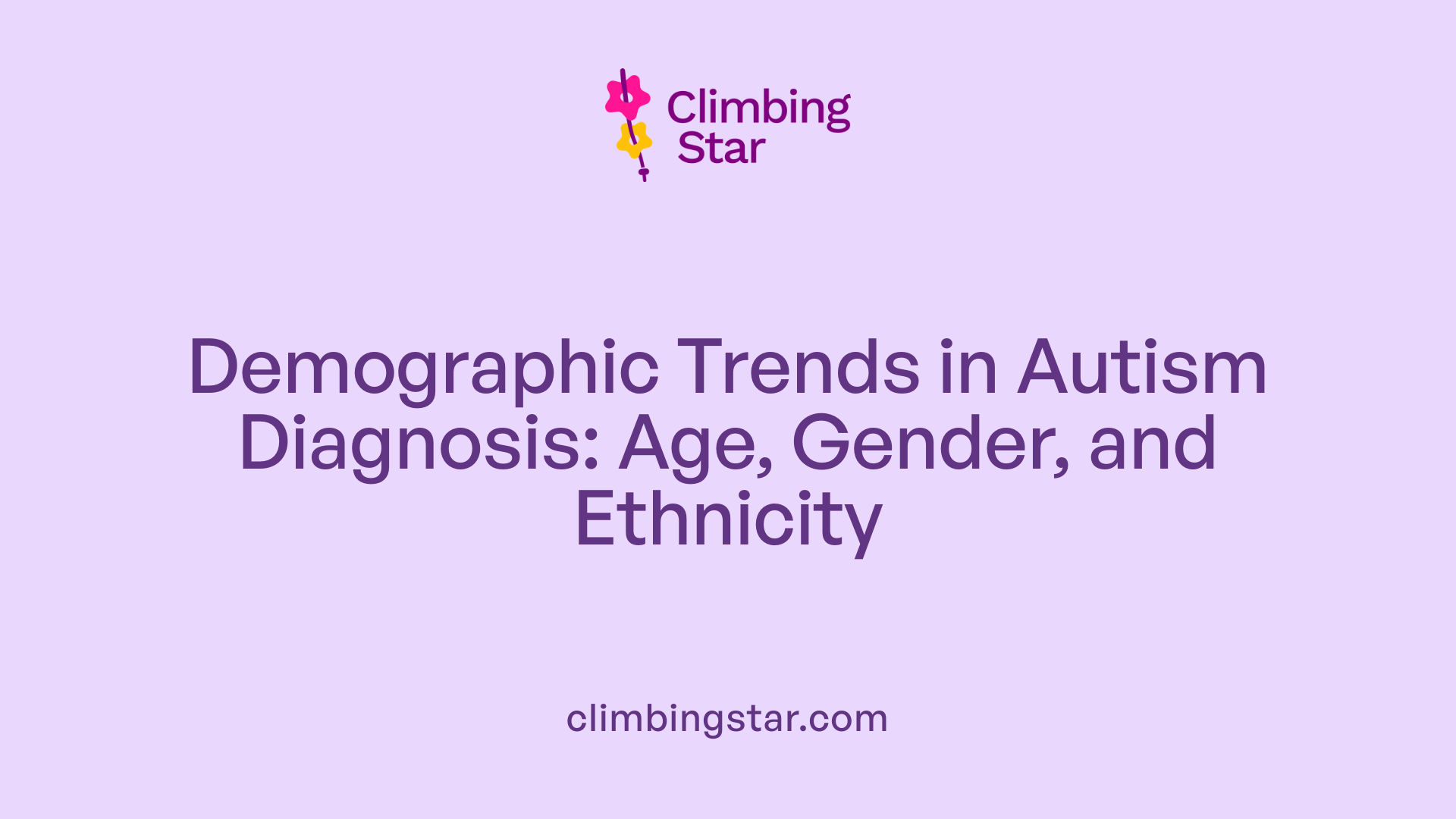
Rising Diagnosis Rates Among Children and Adults
Autism spectrum disorder (ASD) diagnoses have surged significantly in recent years. From 2011 to 2022, diagnosed cases increased by approximately 175% overall in the United States. This growth is seen not only among children but also adults. Particularly striking is the 450% rise in diagnoses among adults aged 26 to 34. These trends suggest improved detection and awareness in older populations, emphasizing that autism is a lifelong condition warranting continued support.
Higher Male Prevalence but Narrowing Gender Ratio
ASD remains more commonly diagnosed in males than females. However, the male-to-female prevalence ratio has been declining, from 4.29:1 in children down to 3.01:1 by 2022. While males still demonstrate higher rates, females show a faster rate of increase in diagnosis, hinting at better recognition of autism traits in females which historically have been underdiagnosed.
Increased Diagnosis in Minority Populations
Diagnosis rates have risen across all racial and ethnic groups. Particularly notable are the substantial relative increases among Hispanic and other minority populations, indicative of enhanced outreach, awareness, and access to diagnostic services within these communities. This trend suggests progress toward equitable detection but also underscores the need to continue addressing disparities.
Diagnosis Peaks in Early Childhood
Peak diagnosis rates occur among children aged 5 to 8 years. In 2022, approximately 30.3 per 1000 children in this age bracket were diagnosed with autism. Early childhood remains the critical window for identification, enabling timely intervention. Despite this, diagnoses in older age groups have increased as well, reflecting lifelong considerations for autism diagnosis and support.
These demographic trends highlight a growing and increasingly diverse population of individuals identified with autism, reinforcing the importance of continued efforts in early detection, inclusive healthcare services, and targeted support for all age groups and communities.
Advances in Autism Diagnostic Tools
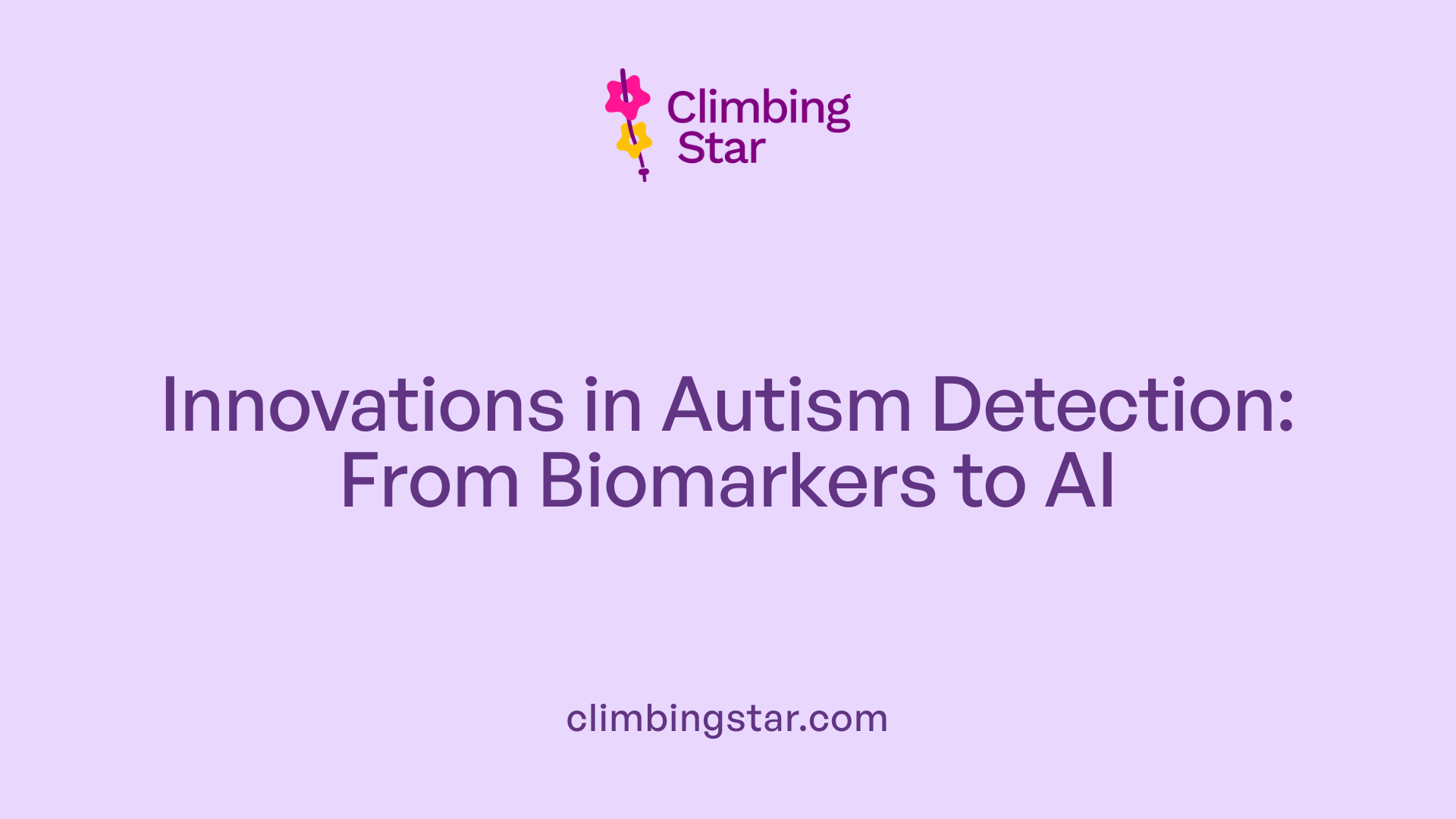
Behavioral Assessments
Behavioral assessments remain the cornerstone of autism spectrum disorder (ASD) diagnosis. Clinicians evaluate social communication, language skills, and repetitive behaviors to identify characteristics of ASD. These assessments are critical due to the broad spectrum of symptoms and severity among individuals.
Emerging Molecular and Digital Biomarkers
Research is actively exploring molecular biomarkers such as gene expression profiles, inflammatory markers, metabolomics, and proteomics that may improve early and objective diagnosis of ASD. Digital biomarkers, derived from behavioral data gathered via digital platforms, are also under investigation to enhance screening precision.
Neuroimaging Techniques and EEG
Advanced neuroimaging methods, including functional magnetic resonance imaging (fMRI) and diffusion tensor imaging (DTI), provide insights into brain connectivity and structure variations in individuals with ASD. Electroencephalography (EEG) offers a non-invasive approach to detect abnormal brain activity patterns that may be associated with ASD.
Eye Tracking and AI-Based Early Screening
Eye tracking technology helps identify atypical gaze patterns linked to ASD at an early age, enabling earlier intervention. Artificial intelligence (AI) enhances screening by analyzing behavioral patterns from videos and other data sources, facilitating faster and potentially more accurate identification.
These advancements in diagnostic tools promise earlier and more precise detection of ASD, which is critical for timely intervention and improved outcomes.
Applied Behavior Analysis (ABA) Therapy: Principles and Methods

What is Applied Behavior Analysis (ABA) therapy and how does it work?
Applied Behavior Analysis (ABA) therapy is a scientifically grounded method designed to support individuals with autism in enhancing their skills and managing challenging behaviors. It relies on the principles of behavior analysis, focusing on understanding the relationships between antecedents (what happens before a behavior), the behavior itself, and the consequences that follow. By carefully analyzing these elements, ABA therapists can develop strategies to encourage positive behaviors and reduce those that interfere with learning or social interaction.
Scientific basis of ABA
ABA is rooted in the science of learning and behavior. It uses evidence-based interventions to modify behaviors by reinforcing desired actions. Positive reinforcement — providing rewards or incentives after a behavior — is a cornerstone technique. These methods aim to increase adaptive behaviors and functional skills, such as communication, social interactions, and daily living activities.
Behavior analysis and modification techniques
Key techniques employed in ABA include:
- Positive reinforcement: Encouraging behaviors by rewarding them, making it more likely they will occur again.
- Prompting: Offering cues or assistance to initiate desired behaviors.
- Discrete Trial Training (DTT): Structured teaching method that breaks skills into small steps, teaching one at a time with clear instructions and immediate feedback.
- Naturalistic teaching: Learning opportunities embedded in everyday activities, promoting generalization and spontaneous use of skills.
Individualized treatment planning
ABA programs are tailored to meet the unique needs of each individual. This customization is based on comprehensive assessments that identify strengths, challenges, and specific goals. Treatment plans outline targeted skills and behaviors to address, ensuring therapy is relevant and effective. ABA interventions are delivered by trained professionals who continuously monitor progress and adjust strategies accordingly, fostering meaningful and lasting improvements.
Professionals Delivering ABA Therapy and Their Credentials

Roles of BCBAs, BCaBAs, and RBTs
Applied Behavior Analysis (ABA) therapy is delivered by a team of professionals with varying responsibilities. At the top are Board Certified Behavior Analysts (BCBAs), who hold a master’s degree and have completed supervised fieldwork and certification. They design individualized treatment plans and oversee the therapy process.
Below BCBAs are Board Certified Assistant Behavior Analysts (BCaBAs), who typically have a bachelor's degree and experience in behavioral science. BCaBAs provide support to BCBAs and can supervise Registered Behavior Technicians (RBTs).
Registered Behavior Technicians are paraprofessionals trained to implement ABA therapy directly with clients. They work under the close supervision of BCBAs or BCaBAs, delivering hands-on treatment.
Educational and Certification Requirements
BCBAs require at least a master’s degree in behavior analysis or a related field, completion of specified supervised clinical hours, and passing a certification exam. BCaBAs must have a bachelor’s degree and meet supervision hours, along with certification. RBTs undergo specific training and competency assessments to practice.
Collaborative Treatment Supervision and Delivery
The team approach ensures that treatment plans are developed by BCBAs and executed by RBTs, with BCaBAs providing supervision and support. This collaboration guarantees that interventions are tailored and adjusted based on ongoing progress.
Emphasis on Ethics and Caregiver Involvement
Ethical practice is central, with professionals adhering to guidelines that emphasize respect and consent. Caregivers are actively involved in the therapeutic process, training to continue support beyond therapy sessions, enhancing consistency and effectiveness.
Benefits and Effectiveness of ABA Therapy for Autism
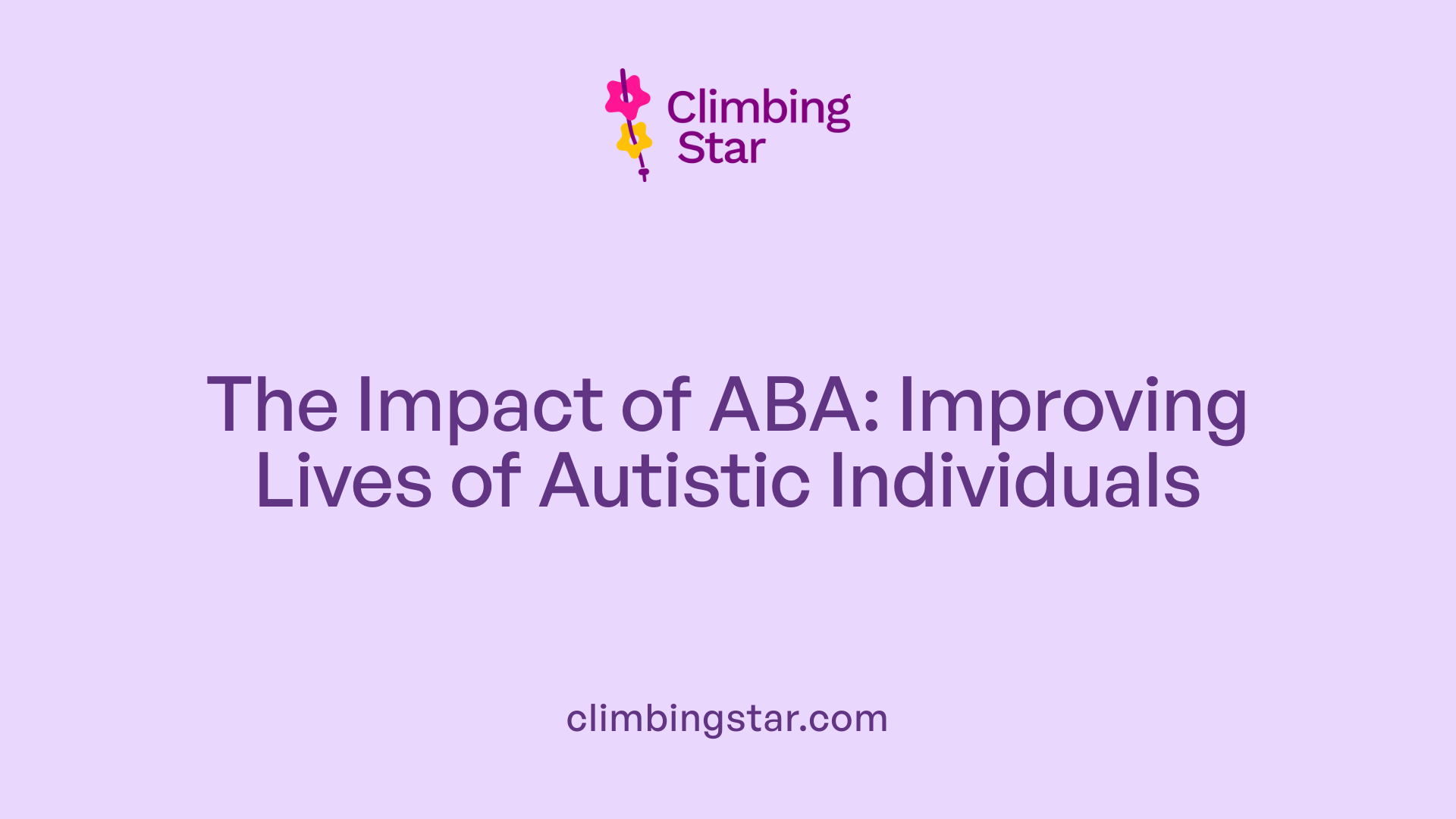
What are the main benefits of ABA therapy for individuals with autism?
Applied Behavior Analysis (ABA) therapy is a widely recognized and evidence-based intervention for individuals with autism spectrum disorder (ASD). Its primary benefits include marked improvements in communication and social skills, which are often challenging areas for autistic individuals.
ABA therapy uses positive reinforcement techniques to encourage skill acquisition, helping individuals develop critical daily living skills and reduce maladaptive behaviors, such as aggression or self-injury. By analyzing behaviors and systematically teaching new skills, ABA supports a more adaptive and functional lifestyle.
How does early intervention impact outcomes?
Early intervention with ABA, especially when started before the age of six, can lead to significant developmental gains. Children receiving intensive ABA programs often show improvements in language abilities, social interactions, and self-care skills. These early gains can enhance long-term independence and quality of life.
In what settings is ABA therapy implemented, and how is it supervised?
ABA therapy is versatile and can be effectively implemented in various settings, including at home, in schools, or in community environments. Qualified behavior analysts design individualized treatment plans tailored to each person's unique needs. This oversight ensures that interventions remain appropriate and effective, adjusting as the individual progresses.
Overall, ABA therapy’s structured approach to behavior modification, skill development, and individualized plans makes it a cornerstone treatment for improving the lives of autistic individuals.
Measuring ABA Therapy Outcomes
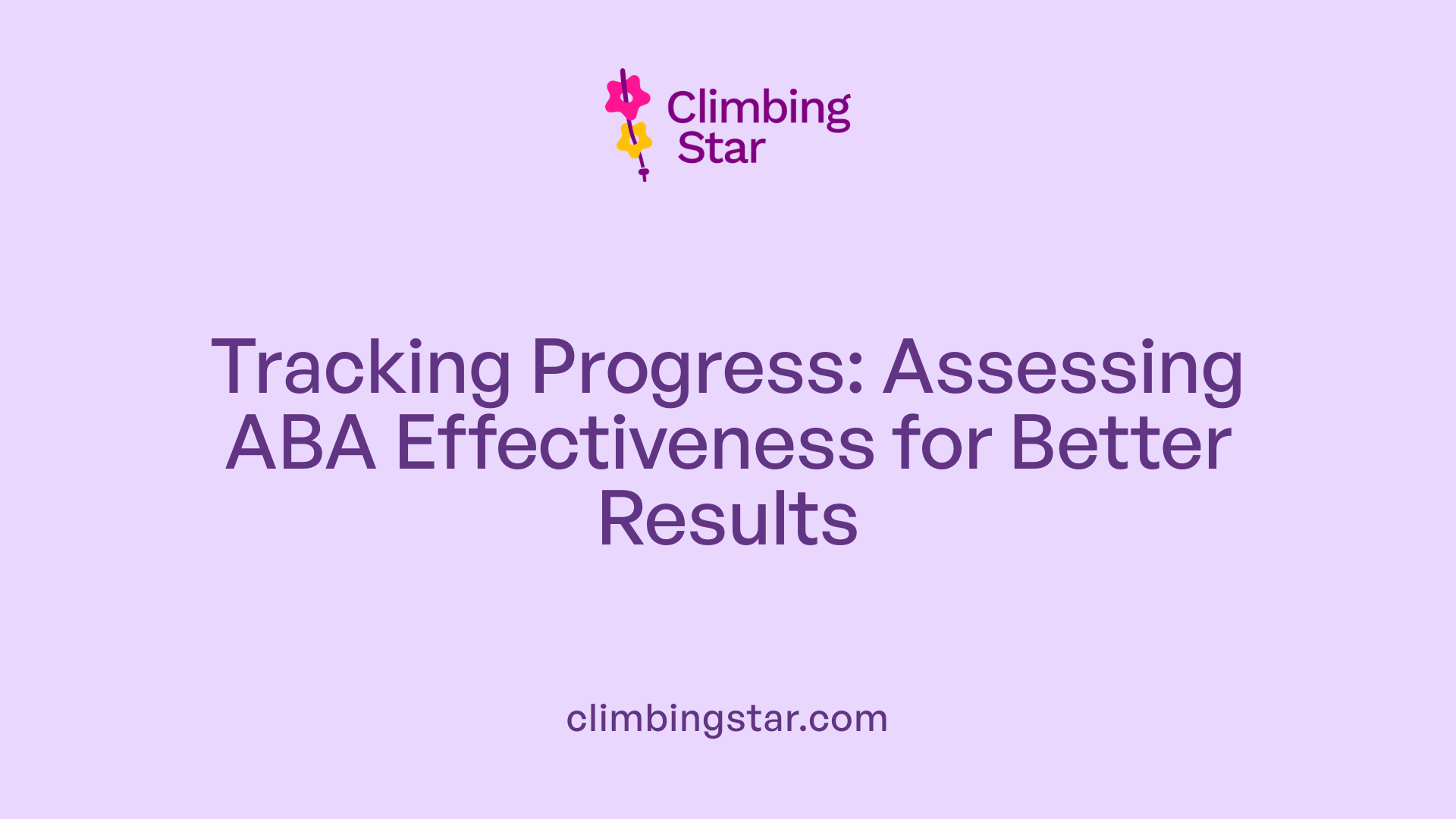
Systematic Data Collection and Progress Monitoring
Effectiveness in ABA therapy hinges on consistent, systematic data collection, enabling therapists to monitor progress over time. By tracking specific behaviors, patterns emerge that inform treatment adjustments.
Tracking Behavior Frequency, Duration, and Intensity
Data includes the frequency with which a behavior occurs, how long it lasts, and its intensity. This detailed tracking employs charts and digital tools to quantify changes precisely, providing objective evidence of improvement or areas needing attention.
Assessment of Skill Acquisition and Behavior Reduction
Progress isn't solely about reducing problematic behaviors; it also emphasizes skill acquisition in communication, social interactions, and daily functioning. Therapists evaluate both the increase in adaptive skills and the decrease in maladaptive behaviors to gauge overall effectiveness.
Role of Parental Involvement and Generalization of Skills
Parents play a vital role by reinforcing learned skills at home and in broader settings. Successful ABA therapy means that skills generalize beyond therapy sessions into everyday routines, ensuring that improvements are meaningful and sustainable.
Collectively, these measurement strategies provide a comprehensive picture of ABA therapy outcomes, guiding personalized treatment and fostering lasting behavioral change.
Critiques and Controversies Surrounding ABA Therapy

What Are the Criticisms and Controversies Related to ABA Therapy?
Applied Behavior Analysis (ABA) therapy, historically a leading intervention for autism spectrum disorder (ASD), has experienced significant critiques. Early forms of ABA sometimes employed aversive methods, including electric shocks, to reduce unwanted behaviors. Such approaches caused considerable ethical concerns and emotional distress.
Today, a primary criticism focuses on the therapy’s potential overemphasis on compliance and normalization. Some autistic self-advocates and clinicians warn that this can suppress natural autistic behaviors and encourage masking—where individuals conceal their authentic self to appear neurotypical. This masking is linked with emotional harm, including anxiety, trauma, and lowered self-esteem.
How Has ABA Therapy Evolved to Address These Concerns?
In response to these controversies, ABA has evolved toward more positive, person-centered approaches. Contemporary ABA heavily emphasizes positive reinforcement and naturalistic teaching strategies that promote skill-building without coercion or punishment. There is a growing focus on supporting independence, communication, and quality of life rather than simply enforcing compliance.
Why Is Ethical Implementation Important?
The ongoing debate over ABA therapy underscores the necessity of ethical practices that prioritize the individual’s well-being. Respecting neurodiversity and collaborating with autistic individuals to tailor interventions fosters a more supportive and less harmful therapy environment.
| Aspect | Past Practices | Current Approaches |
|---|---|---|
| Techniques Used | Aversive methods like electric shocks | Positive reinforcement, naturalistic teaching |
| Focus | Compliance to appear neurotypical | Supporting independence and authentic behavior |
| Concerns Raised | Emotional distress, trauma, masking | Ethical care, respect for neurodiversity |
This evolution in ABA reflects a broader shift in autism care toward dignity, respect, and individualized support.
Emerging and Experimental Therapeutic Approaches in ASD

Digital and Brain Stimulation Methods
Recent advances in technology have introduced novel digital and brain stimulation techniques as promising therapeutic options for ASD. These include neuromodulation strategies such as transcranial magnetic stimulation (TMS) and transcranial direct current stimulation (tDCS), which aim to alter neural activity to improve social and cognitive functions. Additionally, technology-assisted interventions like virtual reality and AI-driven behavioral analysis provide innovative platforms for social skills training and personalized therapy.
Pharmacological Agents Targeting Oxidative Stress and Neuroinflammation
Pharmacological research focuses on drugs that mitigate oxidative stress and neuroinflammation, two mechanisms implicated in ASD pathogenesis. Experimental agents include PPAR agonists, mTOR inhibitors, and vasopressin receptor antagonists. Oxytocin, known for its role in social bonding, is being tested for its potential to improve social deficits. While many treatments remain experimental, they reflect a targeted approach to underlying biological disruptions in ASD.
Targeted Metabolic Therapies: Leucovorin for Cerebral Folate Deficiency
Leucovorin, a form of active folate, has emerged as a targeted metabolic therapy for cerebral folate deficiency (CFD), a condition associated with autistic features. CFD is characterized by insufficient brain folate despite normal systemic levels and is linked to genetic mutations or autoimmune factors disrupting folate transport. Leucovorin circumvents these defects by delivering folate directly to the brain. Clinical studies show that approximately 85% of patients with CFD experience improvements, underscoring leucovorin’s potential as a precision treatment.
Gene Editing and Stem Cell Therapies Prospects
Looking further ahead, gene editing and stem cell therapies represent groundbreaking approaches under exploration. Gene editing holds promise for correcting specific genetic mutations associated with ASD, potentially modifying disease course at a molecular level. Stem cell therapy aims to repair or regenerate dysfunctional neural pathways. Though still in early development stages, these therapies exemplify the move toward precision medicine tailored to individual genetic and biological profiles.
These emerging and experimental approaches expand the therapeutic landscape of ASD, moving beyond conventional behavioral and symptomatic treatments toward interventions that address root biological mechanisms.
Addressing Healthcare and Social Needs of the Growing Autistic Population

Need for Expanded Healthcare Services for Adolescents and Adults
The rising prevalence of autism, now affecting about 1 in 36 children in the US, has highlighted the urgent need for expanded healthcare services beyond childhood. Diagnosis rates are increasing not only among children but also in adolescents and adults, such as a 450% rise among 26-to-34-year-olds. This shift demands healthcare systems adapt to support autistic individuals throughout their lifespan.
Disparities in Diagnosis and Access to Care
Studies reveal disparities in autism diagnosis rates and healthcare access across racial, ethnic, and gender groups. Although diagnosis rates have increased across all populations, Hispanic and minority groups show the most significant relative gains, suggesting improved outreach but still indicating gaps in equitable care. Females are diagnosed less often than males, but their diagnosis rates rise faster, narrowing the gender gap. Addressing these disparities is vital for fair healthcare delivery.
Policies Supporting Early Diagnosis, Research, and Social Integration
Government policies play a pivotal role in promoting early autism diagnosis, funding research, and fostering social integration. Early screening programs using advanced technologies like AI and eye tracking are increasingly supported, enabling earlier interventions. Social policies also encourage inclusion in educational settings and employment opportunities for autistic individuals, thereby improving quality of life.
Importance of Accessible Interventions Across the Lifespan
Effective interventions, including behavioral therapies like Applied Behavior Analysis (ABA), social skills training, and pharmacological treatments for symptom management, must be accessible from childhood through adulthood. Emerging therapies such as neuromodulation and digital tools offer promising adjuncts. Lifelong access to these supports, coupled with coordinated health promotion and rehabilitation, is essential to meet the complex needs of autistic persons.
| Aspect | Highlights | Importance |
|---|---|---|
| Expanded Healthcare | Rising diagnoses in adolescents and adults | Ensures continued support beyond childhood |
| Addressing Disparities | Increased diagnosis in minority and female populations | Promotes equitable access and early care |
| Policy Initiatives | Support early detection, research funding, social inclusion | Enables comprehensive support and community integration |
| Lifespan Interventions | Behavioral, pharmacological, and technological therapies throughout life | Maintains functional independence and well-being |
Global Initiatives and Future Directions in Autism Research
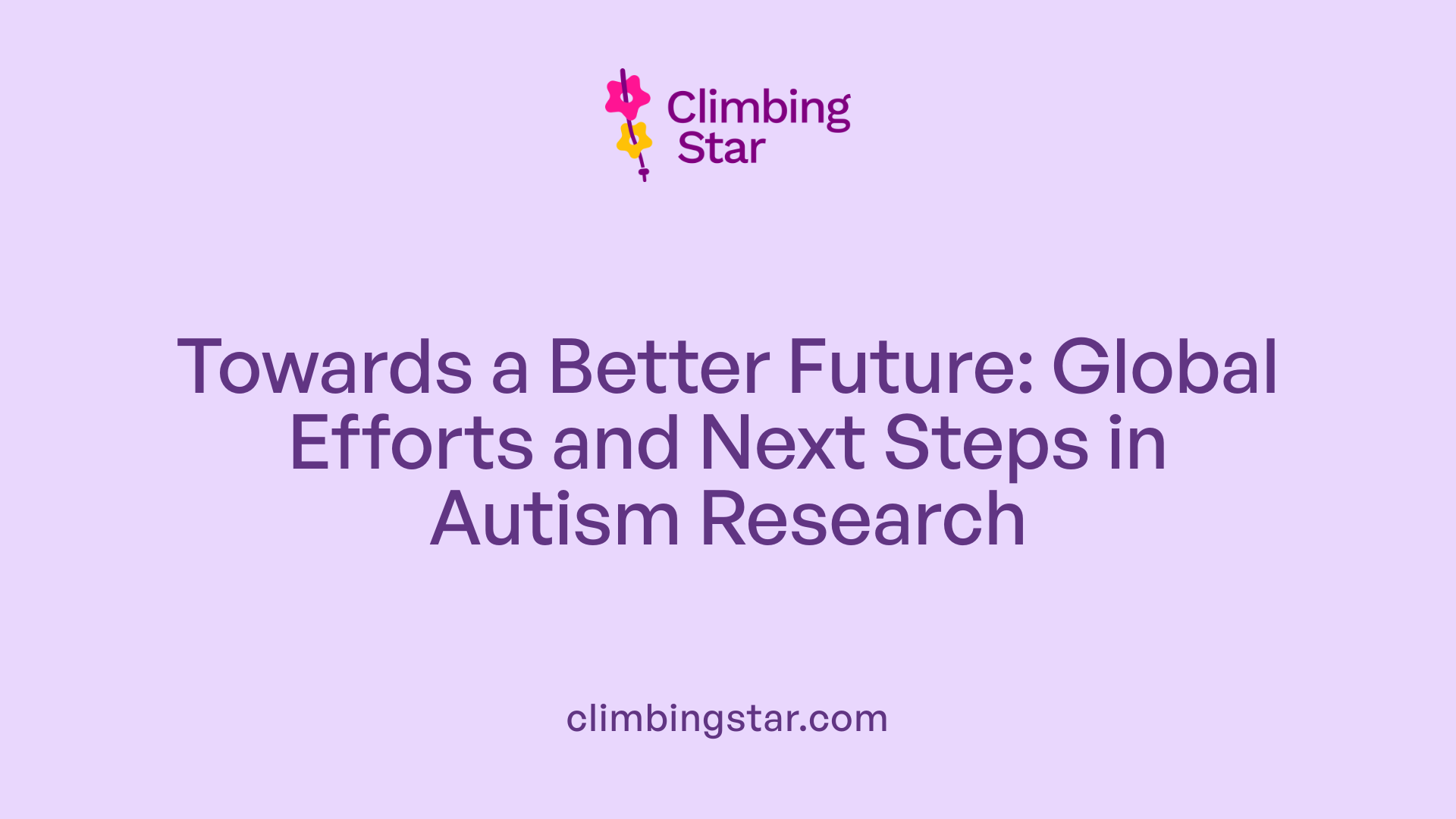
Large-scale data integration initiatives like NIH ADSI
The NIH Autism Data Science Initiative (ADSI) represents a pivotal movement in autism research, focusing on the integration of genomic, environmental, medical, and behavioral data. This comprehensive approach aims to unravel the complex etiology of autism spectrum disorders (ASD) by analyzing vast datasets to identify subtle interactions and risk factors that were historically difficult to detect. Integration across multiple data types enhances the understanding of autism’s heterogeneity and supports the development of targeted interventions.
Exposomics and environmental factor studies
Aligned with data integration efforts is the growing field of exposomics. This discipline investigates environmental exposures throughout the lifespan, including maternal diet, pollutants, perinatal influences, and psychosocial factors. Exposomics complements genetic research by identifying how environmental contributors may trigger or modify ASD risk, particularly through mechanisms like neuroinflammation and mitochondrial dysfunction. These insights offer potential avenues for prevention by managing exposures during critical developmental windows.
Development of biomarkers for precision medicine
A crucial goal emerging from these research initiatives is the discovery and validation of biomarkers that can guide precision medicine approaches in ASD. Biomarkers under exploration include molecular indicators such as gene expression profiles, inflammatory markers, proteomics, metabolomics, and microbiota compositions. Early and accurate diagnosis facilitated by biomarkers could enhance patient-specific treatment strategies and improve long-term outcomes.
WHO resolutions promoting inclusive policies and effective care
At the policy level, the World Health Organization (WHO) has adopted resolutions aimed at improving global capacities for managing autism. These policies emphasize early detection, access to evidence-based care, and creating inclusive environments that support autistic individuals throughout their lifespan. The WHO’s initiatives foster collaboration across health, education, and social sectors, promoting stigma reduction and enabling equitable access to services worldwide.
Together, these global initiatives underscore a shift towards a more integrated, personalized, and inclusive framework for understanding and supporting individuals with autism spectrum disorders.
Implications of Increasing Autism Awareness and Diagnosis
The rising prevalence of autism diagnoses highlights advances in our understanding of this complex neurodevelopmental condition. While genetic and environmental factors shape autism's etiology, improved diagnostic criteria, screening tools, and societal awareness largely explain the increase in identified cases. Effective therapies such as ABA have enhanced developmental outcomes, though ongoing dialogue and innovation remain critical to ethical and individualized care. As the autism community grows more diverse, expanded healthcare services and supportive policies are essential to meet evolving needs and foster inclusion throughout the lifespan.
References
- Understanding autism: Causes, diagnosis, and advancing ...
- New advances in the diagnosis and treatment of autism ...
- Autism Diagnosis Among US Children and Adults, 2011- ...
- Is There an Autism Epidemic? | Johns Hopkins
- Autism Announcement Fact Sheet
- Autism
- Understanding Your Child's ABA Therapy Providers
- Applied Behavior Analysis (ABA)
- The Top 10 Reasons Children With Autism Deserve ABA
- Applied Behavior Analysis (ABA)







